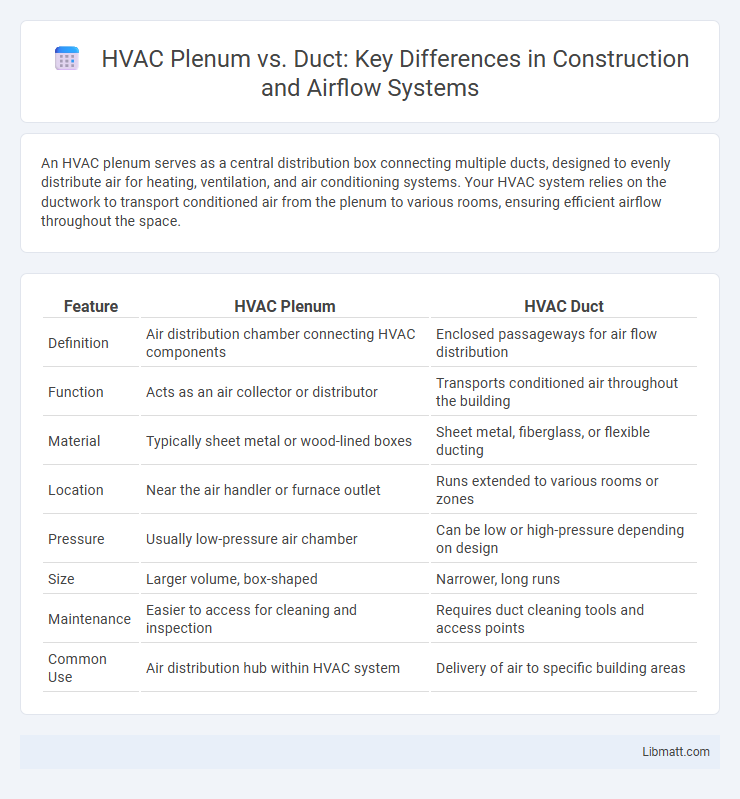An HVAC plenum serves as a central distribution box connecting multiple ducts, designed to evenly distribute air for heating, ventilation, and air conditioning systems. Your HVAC system relies on the ductwork to transport conditioned air from the plenum to various rooms, ensuring efficient airflow throughout the space.
Table of Comparison
| Feature | HVAC Plenum | HVAC Duct |
|---|---|---|
| Definition | Air distribution chamber connecting HVAC components | Enclosed passageways for air flow distribution |
| Function | Acts as an air collector or distributor | Transports conditioned air throughout the building |
| Material | Typically sheet metal or wood-lined boxes | Sheet metal, fiberglass, or flexible ducting |
| Location | Near the air handler or furnace outlet | Runs extended to various rooms or zones |
| Pressure | Usually low-pressure air chamber | Can be low or high-pressure depending on design |
| Size | Larger volume, box-shaped | Narrower, long runs |
| Maintenance | Easier to access for cleaning and inspection | Requires duct cleaning tools and access points |
| Common Use | Air distribution hub within HVAC system | Delivery of air to specific building areas |
Understanding HVAC Plenum and Duct: Key Differences
HVAC plenums serve as central distribution boxes where conditioned air is collected or supplied, typically located directly after air handlers or furnaces, while ducts are the network of passages that deliver air from plenums to various rooms. Plenums are usually constructed from galvanized steel and are larger, smooth boxes designed to reduce air turbulence and noise, whereas ducts can be made from sheet metal, flexible materials, or fiberglass and vary in shape and size to fit building layouts. Understanding the key functional and structural differences between plenums and ducts is essential for optimizing HVAC system efficiency and indoor air quality.
What is an HVAC Plenum?
An HVAC plenum is a central air distribution box connecting the main heating and cooling system to the ductwork, designed to evenly channel air throughout a building. Unlike standard ducts, plenums serve as a transition space that regulates air pressure and flow between the HVAC unit and branch ducts. Proper plenum design enhances system efficiency and reduces noise by providing balanced air distribution in commercial and residential HVAC systems.
What is an HVAC Duct?
An HVAC duct is a passageway used in heating, ventilation, and air conditioning systems to deliver and remove air. Typically made from sheet metal, fiberglass, or flexible materials, ducts connect the HVAC unit to different areas within a building. Properly sealed and insulated ducts optimize airflow efficiency and maintain indoor air quality.
Types of HVAC Plenums
HVAC plenums include supply plenums, return plenums, and exhaust plenums, each serving distinct roles in air distribution systems. Supply plenums distribute conditioned air from the HVAC unit to ductwork, while return plenums collect air from various spaces to be reconditioned or exhausted. Exhaust plenums are designed to vent stale or contaminated air directly outside, ensuring efficient airflow and indoor air quality.
Types of HVAC Ducts
HVAC ducts come in various types, including rectangular, round, and oval shapes, each designed to optimize airflow and fit specific installation requirements. Rectangular ducts are commonly used for their space efficiency in tight areas, while round ducts offer better airflow dynamics and reduced leakage. Your choice of duct type impacts system performance and energy efficiency, making it essential to select the right duct shape for your HVAC plenum and overall ventilation design.
Plenum vs Duct: Airflow Efficiency Comparison
An HVAC plenum is a central air distribution box designed to evenly channel conditioned air, while ducts are the pathways that carry air throughout the building. Plenums provide improved airflow efficiency by minimizing turbulence and resistance, leading to more consistent air pressure and distribution compared to traditional ducts. Optimizing your HVAC system with a properly designed plenum can enhance overall airflow performance and energy efficiency.
Installation Differences: Plenum and Ductwork
HVAC plenum installation involves connecting a large, sealed metal box directly to the air handler or furnace to distribute conditioned air, requiring precise sealing to maintain pressure and avoid leaks. Duct installation, by comparison, consists of running multiple smaller sections of metal, fiberglass, or flexible material throughout the building, which demands careful layout to ensure efficient airflow and proper insulation. Your choice between plenum and ductwork affects the complexity and methods used during installation, influencing overall system performance and energy efficiency.
Maintenance Needs: Plenum vs Duct
HVAC plenums require regular inspection to prevent dust and debris accumulation that can restrict airflow and reduce system efficiency, while ducts often need sealing and cleaning to avoid air leaks and maintain indoor air quality. You should prioritize access points and visual checks in plenums since contamination directly affects filter performance and air distribution. Routine duct maintenance includes checking for mold and insulation damage to ensure optimal heating and cooling delivery throughout the space.
Cost Considerations: Plenum vs Duct Systems
Cost considerations between HVAC plenum and duct systems hinge on material and installation expenses. Plenum systems, often made from sheet metal or insulated panels, generally incur higher upfront costs due to specialized fabrication and fire-resistant requirements. Your choice could impact long-term expenses as duct systems typically offer more affordable maintenance and repair options.
Choosing the Right Option: Plenum or Duct for Your HVAC System
An HVAC plenum serves as an air distribution box that connects the HVAC unit to the ductwork, facilitating efficient airflow and pressure regulation, while ducts are the channels that deliver conditioned air throughout the building. Choosing the right option depends on building design, system capacity, and noise control needs; plenums are ideal for centralizing airflow and reducing noise, whereas ducts offer flexibility in directing air to multiple rooms. Proper sizing and material selection for both plenums and ducts ensure optimal HVAC performance, energy efficiency, and indoor air quality.
HVAC plenum vs duct Infographic

 libmatt.com
libmatt.com